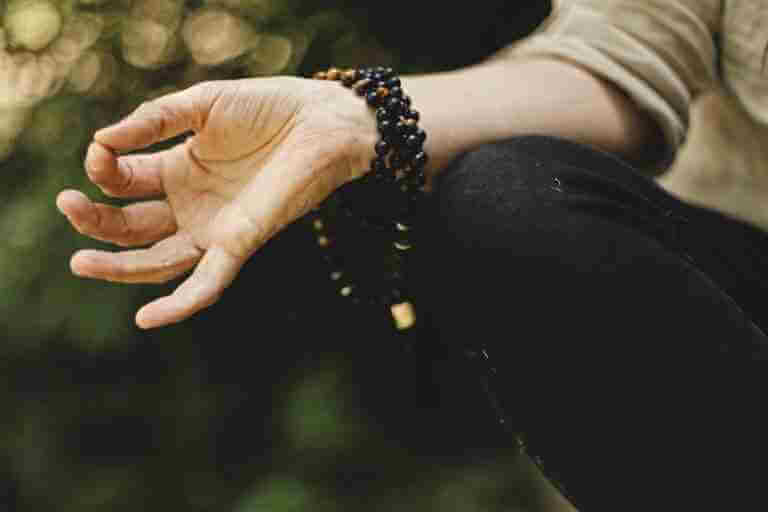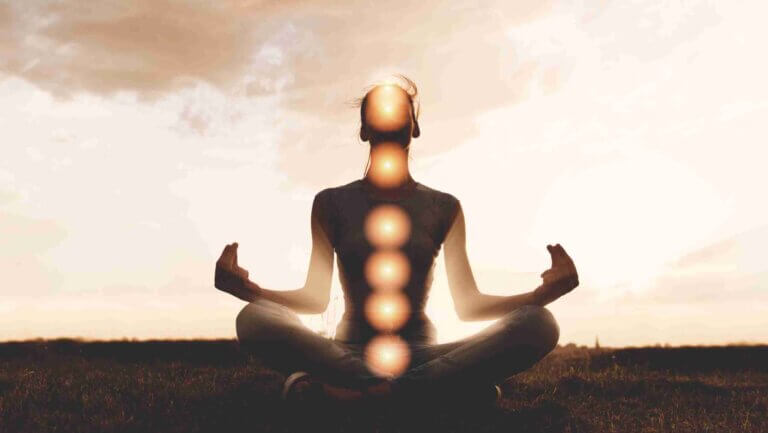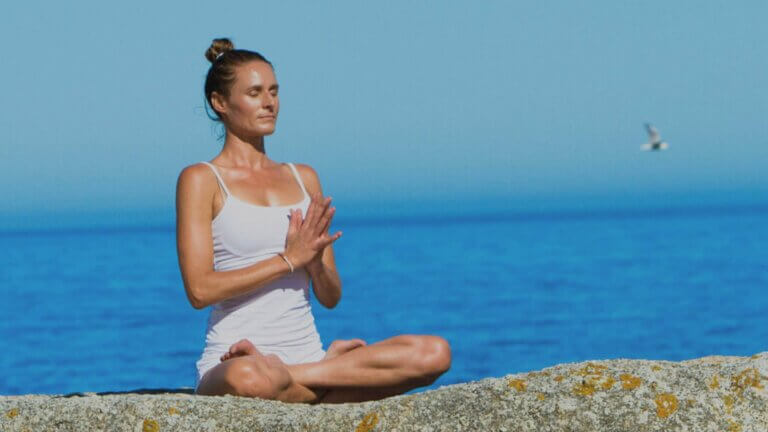Home » Yoga Blog » Meditation Blog » Mudras and Mantras Two Powerful Meditation Tools Explained
Mudras and Mantras: Two Powerful Tools for Profound Inner State Changes
Mudras and mantras are two powerful tools used for centuries in meditation practices. Mudras are hand gestures used to connect with specific energies in the body, while mantras are short phrases or seed sounds chanted to focus the mind and connect with the inner self.
Combining mudras and mantras in your meditation practice can have therapeutic effects on your whole body and help you develop well-developed neural pathways and profound changes in your inner state.
Please Note: This text speaks to hand mudras and their use in meditation practice. A future article will cover Hatha Yoga mudras with asana, pranayama and bandha.
What are Mudras, and what do they mean?
The word mudra has Sanskrit roots. It means “seal” or “any other instrument used for sealing”.
The concept of Mudras is that our hands connect to different areas of our body, and each finger is associated with a specific element and chakra.
- The thumb represents the fire element and the solar plexus chakra.
- The index finger represents the air element and the heart chakra.
- The middle finger represents the ether element and the throat chakra.
- The ring finger represents the earth element and the root chakra.
- The pinky finger represents the water element and the sacral chakra.
You can activate these chakras and energies in your body by placing your right hand and left hand in specific mudras.

Some Mudra Examples
Perhaps the most well-known, Anjali Mudra, is used in many religious disciplines and yoga practices and is seen in many works of art.
Placing both hands together (prayer hands) in front of your chest (Heart Chakra) is Anjali Mudra. Practitioners add Anjali Mudra to enhance yoga postures such as Yogi Squat Pose (malasana).
In some cultures, its offered as a greeting or salutation along with the word Namaste. This mudra helps alleviate mental stress and anxiety and assists in achieving focus and a meditative state.
A common and straightforward mudra is the Gyan mudra, “Mudra of Wisdom or Knowledge,” formed by touching the tip of the thumb to the tip of the index finger with the palms facing down. This mudra enhances concentration and grounding and relaxes the nervous system.
Another popular mudra is the Vayu mudra, “Mudra of Air,” which is formed by placing the tip of the index fingertip on the base of the thumb and applying gentle pressure with the thumb. This mudra is said to relieve stress and anxiety.

Mudras to Balance and Connect the Chakras
Some Examples of using mudras to balance, connect and unblock Chakras
Form the Rudra “howler” mudra by touching the ring finger (root chakra) and index finger (heart chakra) tip to the thumb (solar plexus) tip while extending the remaining fingers. Use this mudra to increase self-confidence and self-esteem.
Make the Shuni “Saturn” mudra by touching the tip of the middle finger (throat Chakra) to the tip of the thumb (solar plexus chakra). Use this mudra for mental energy around patience, positivity, focus, and awareness.

What are Mantras, and what do they mean?
Mantras are Sanskrit words or short phrases chanted repeatedly to focus the mind and connect with the inner self.
The word mantra is derived from the Sanskrit word “mana” (to think). Chanting mantras can help you achieve a deeper state of meditation and connect with your inner self.
A targeted chakra mantra practice can help unblock a chakra. Your can learn more from our Heat Chakra Mantras Article
Some Examples of Mantras
Common mantras include “Om,” which is considered the most powerful mantra and represents the sound of the universe.
Another is “Om Shanti Shanti Shanti,” which means “peace for the body, speech, and mind.” Each mantra has its specific meaning and purpose.
Bringing Mudras and Mantras Together in a Meditation Practice
Combining mudras and mantras in your meditation practice can help you achieve profound changes in your inner state.
When you place your hands in a mudra, you activate specific energies in your body, while chanting a mantra can help you focus your mind and connect with your inner self.
This combination can help you achieve a deeper state of meditation and experience therapeutic effects on your physical body and nervous system.
A Simple Guideline to a Mudras and Mantras Practice
Steps to a Mudras and Mantras Practice
- Find a quiet space where you can practice without distractions.
- Sit comfortably with your back straight and your hands resting on your knees.
- Take a few deep breaths to relax your body and mind.
- Next, choose a specific mudra that resonates with you and place your hands in that position.
- Then, choose a mantra you want to chant and repeat it silently or aloud.
- Focus your attention on the energy you are trying to activate through the mudra and the meaning of the mantra.
- Visualize the energy moving through your body as you chant the mantra.

Some Mudras and Mantras Combinations
For example, you can try the Chin mudra and chant the mantra “Om” to enhance your concentration and stimulate your nervous system.
- First, place the tip of your thumb and index finger together and palm up. Chant “Om” silently or aloud.
- Then, focus on the space between your eyebrows (third eye chakra) and visualize a bright light radiating. Repeat the mantra for a few minutes or as long as you feel comfortable.
Another simple mudras and mantras combination is the Gyan mudra with the Mantra “Lam.”
- Form Gyan by touching the tip of your index finger to the tip of your thumb, extending your remaining fingers and your palms facing down.
- This mudra stimulates the root chakra and can help you feel grounded and connected to the earth.
- Chant the seed sound “Lam” while holding this mudra to activate the root chakra. Next, focus on the base of your spine and visualize a red light glowing in that area.
Inner State Changes from Practicing with Mudras and Mantras
As you continue to practice mudras and mantras, you may notice changes in your inner state and well-being. For example, regular practice can help you develop well-developed neural pathways to enhance concentration, creativity, and self-awareness.
You may also experience therapeutic effects on your physical body, such as reduced stress and anxiety, improved sleep, and increased energy.
It’s crucial to note practice mudras and mantras with awareness and intention. They are potent tools that can profoundly affect your inner state but are not a substitute for medical treatment or therapy.
Consult a qualified meditation teacher or healthcare professional if you have concerns about your personal practice.

A final word on the Benefits of Mudras and Mantras
Mudras and mantras are powerful tools that can enhance your meditation practice and help you achieve profound changes in your inner state.
Using hand gestures to activate specific energies in your body and chanting short phrases to focus your mind, you can develop well-developed neural pathways and experience therapeutic effects on your physical body and nervous system.
If you are new to mudras and mantras, start with simple practices and gradually explore specific mudras and mantras that resonate with you.
With regular practice, you can unlock the power of these ancient tools and enhance your well-being. So next time you meditate, try incorporating mudras and mantras into your practice and see what profound changes you can achieve.
Sources


